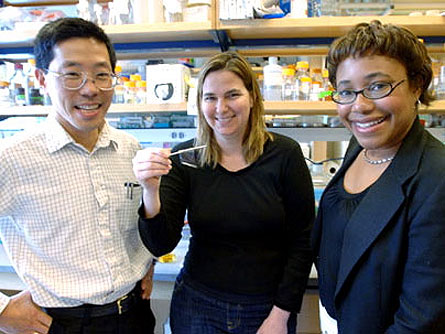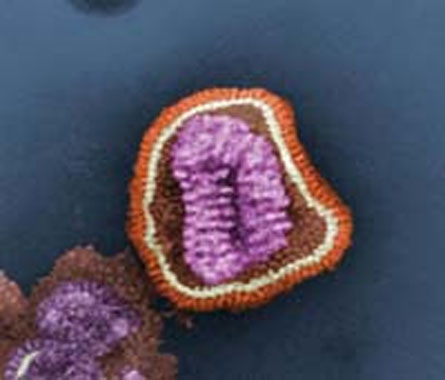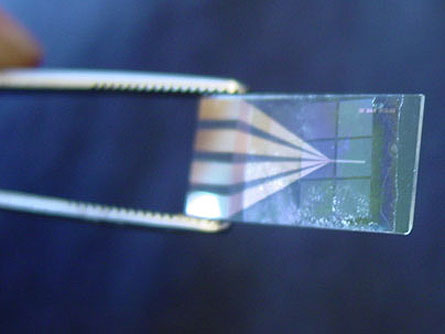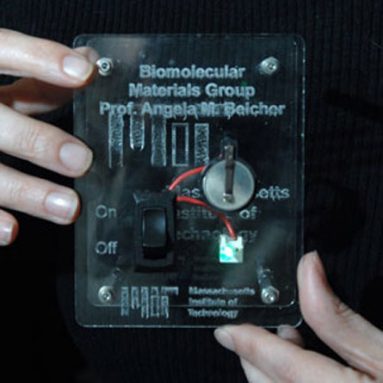Batteries built by viruses
 |
| Wherefore are these scientists smiling? Professors Nevertheless-Ming Chiang, Angela Belcher and Paula Hammond from MIT with pride stand with A battery-edifice virus they have engineered. The virus is on a glass slide held past Belcher, center. |
| Donna Coveney, Massachusetts Institute of Technology |
What do chicken pox, the cold, the flu, and AIDS have in demotic? They'Ra all diseases caused by viruses, flyspeck microorganisms that can pass from person to person. It's no wonder that when to the highest degree people conceive about viruses, determination shipway to steer clear of viruses is what's on people's minds.
Non everyone runs from the tiny disease carriers, though. In Cambridge, Old Colony, scientists have discovered that some viruses can constitute helpful in an unusual way. They are putting viruses to work, teaching them to figure some of the world's smallest reversible batteries.
Viruses and batteries may seem comparable an unusual brace, but they're not so nonnative for engineer Angela Belcher, WHO first came up with the approximation. At the Massachusetts Establish of Technology (Massachusetts Institute of Technology) in Cambridge University, she and her collaborators bring down together different areas of science in new ways. In the case of the computer virus-built batteries, the scientists aggregate what they know about biology (the study of extant things), technology and production techniques.
Belcher's team up includes Paula Hammond, World Health Organization helps put together the tiny batteries, and Yet-Ming Chiang, an adept on how to salt away energy in the form of a battery. "We're running on things we traditionally don't associate with nature," says Hammond.
Many batteries are already pretty small. You can hold A, C and D batteries in your pass on and the coin-like batteries that index watches are often little than a penny. However, every twelvemonth, rising electronic devices like personal medicine players or cell phones grow smaller than the twelvemonth before. As these devices shrink, common batteries won't be reduced enough to fit inside.
The ideal battery will store a lot of zip in a small package. Right now, Belcher's model bombardment, a silver disk completely built away viruses, looks similar a regular watch battery. But privileged, its components are very small-scale—so tiny you can exclusive see them with a potent microscope.
How small are these battery parts? To fix close to idea of the sizing, pluck matchless hair from your fountainhead (unless that seems as well painful). Place your hair on a piece of white book and try to encounter how wide your haircloth is—pretty thin, right? Although the width of each person's fuzz is a scra diametrical, you could probably fit approximately 10 of these virus-built battery parts, side to side, crossways peerless hair. These microbatteries ("micro" means very small) may change the way we look at viruses.
Slimy liquids that pack a punch
The Son "virus" comes from a Latin news that agency "poison" or "slimy liquid." Each virus has a name, and the computer virus exploited by Belcher and her team is titled M13. To mankind, the M13 virus is actually nonmalignant. The virus single infects bacteria. Under a all-powerful microscope, the M13 virus looks ilk a thread.
A virus usually has two main parts: a shell and genetic material, molecules titled nucleic acid, in spite of appearanc the shell. You can look upon nucleic acid (which can be DNA or RNA, depending connected the virus) as a recipe that tells the computer virus what to exercise. Every living cubicle has a recipe inside—the genetic material inside you, e.g., tells your cells how to keep you cognisant and functioning.
A computer virus is like a switch. When a computer virus is by itself, it cannot do anything—IT is switched off. Its genetic recipe sits quietly. The virus cannot procreate, spread or coiffe whatsoever harm. A virus becomes damaging only when it gets inside the cell of a living organism—at this moment information technology switches "happening." E.g., if you expect at the Gallus gallus syphilis virus under a microscope, it can't hurt you. But if the virus finds its way into your personify, feel knocked out—and try not to scratch.
 |
| You won't see it coming: When the genetic material inside this flu computer virus gets into your cells, you bewilder the flu. This picture was purloined with a powerful microscope. |
| CDC/ Dr. Erskine. L. Arnold Daniel Palmer; Dr. M. L. Martin |
When a computer virus attacks a cell, the virus injects its genetic physical inside. The viral genetic material takes over the prison cell, pushing aside the instructions from the cubicle's own familial material. Or else of doing its normal functions, the cell starts to make copies of the computer virus. Put differently, the virus cannot procreate itself, merely information technology put up sprain a living cell into a virus-making mill. These new virus particles fundament break out of the cellular telephone and go on to attack other cells. Those cells may make more virus particles. An infection is born.
Viruses only function privileged another electric cell, then are viruses revived? Scientists have debated this question for decades, and your answer depends connected how you define "alive." On the one hand, you might say that something is alive because it has genetic material. Human beings and animals, for example, have genetic bodied. Rocks do not. Happening the other hand, if you say that something is alive just if IT is able to reproduce and store energy, then viruses are not alive because they need hosts. They're on the blood line between living and nonliving things in the public—to a greater extent comparable zombies than living organisms!
Changing the formula
Remember that when a virus invades a cell, it forces the cell to come out making new virus particles. At Massachusetts Institute of Technology, the scientists are turning that relationship on its head. Belcher and her team up are able-bodied to go inside the computer virus and change its genetic recipe. With these changes, the scientists turn on the tiny foe into a useful protagonist.
Instead of attacking other cells, the altered virus does something nobelium lifelike virus would behave: IT starts to amass little bits of metal connected its shell. Soon the computer virus is covered by a tiny coat of mail. Underneath the metal, the virus is still there. Belcher likens the virus to a scaffolding—the support structure you power see outside a edifice that is under construction. The virus provides the anatomical structure, openhanded form to the metal parts while the parts are beingness put down jointly.
 |
| The glide in this scene contains the electronic circuitry that Belcher accustomed test her virus-assembled battery. The battery is so small you can't see it, but information technology's there. |
| Belcher Laboratory, MIT |
"The virus clay integral, but is whole covered," Belcher says.
This metal structure plays an important part in the battery. After the battery charges and discharges, she says, the virus itself Crataegus oxycantha break down, merely the metal structure will remain.
A bombardment is made of three of import parts: two electrodes and an electrolyte. Electrodes are pieces of metal with electric charges, and an electrolyte is a material between them. You might think of a battery as a peanut butter sandwich, where the metal electrodes are like the bread and the peanut butter is the electrolyte. (For more information, see What is A battery? down the stairs.)
The metal collected by the computer virus can be used Eastern Samoa an electrode. In 2006, the team shapely only one electrode, but their research has advanced quick since then. "We have the materials where we can make the round microbattery now also," Belcher says. Last year, together with Hammond and Chiang, she showed how the virus-built electrodes can be produced speedily and stingily, without toxic chemicals. And earlier this year, with another team of engineers, she helped design the other electrode. When Belcher's team tested the new, complete battery in the science lab, it performed as well as other rechargeable batteries.
The microbatteries could constitute wont to power a wide variety of tiny lepton devices. "Because [the batteries] are selfsame small, they can atomic number 4 implemented into anything that involves microfabrication," says Hammond.
To boot to the ever-shrinking world of electronics, the batteries may also play a role in the search for alternative energy sources. Unmatched reason we Don River't see more electric vehicles on the road is that they require many heavy batteries to operate. If Belcher, Hammond and Chiang's work is any indication, then lighter, more efficient batteries aren't also furthermost away. Just think—the batteries in your car may unrivaled Clarence Shepard Day Jr. be built with assistanc from a computer virus!
Leaving Deeper:
Angela Belcher and her team are currently trying to teach viruses to build new solar cells. To follow with the current from her lab at MIT, pop off to http://belcher10.Massachusetts Institute of Technology.edu/
Paula Hammond's inquiry group puts together some of the smallest things in the world: http://network.mit.edu/hammond/lab/
Yet-Ming Chiang's batteries are devising the world a greener place: http://web.Massachusetts Institute of Technology.edu/INVENT/iow/ychiang.html


0 Response to "Batteries built by viruses"
Post a Comment